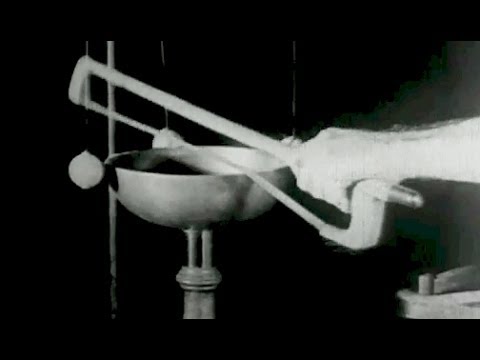Sound Waves: Experiments in Physics circa 1920 Bray Studios; Science Demonstrations
more at
Physics of sound, sound waves, and air pressure are displayed in several interesting classroom examples using tuning forks, a violin bow, sand, and a water jet.
Public domain film from the Prelinger Archives, slightly cropped to remove uneven edges, with the aspect ratio corrected, and mild video noise reduction applied.
The film was silent. I have added music created by myself using the Reaper Digital Audio Workstation and the Independence and Proteus VX VST instrument plugins.
Sound is a mechanical wave that is an oscillation of pressure transmitted through some medium (like air or water), composed of frequencies which are within the range of hearing…
Propagation of sound
Sound is a sequence of waves of pressure that propagates through compressible media such as air or water. (Sound can propagate through solids as well, but there are additional modes of propagation). Sound that is perceptible by humans has frequencies from about 20 Hz to 20,000 Hz. In air at standard temperature and pressure, the corresponding wavelengths of sound waves range from 17 m to 17 mm. During propagation, waves can be reflected, refracted, or attenuated by the medium.
The behavior of sound propagation is generally affected by three things:
– A relationship between density and pressure. This relationship, affected by temperature, determines the speed of sound within the medium.
– The propagation is also affected by the motion of the medium itself. For example, sound moving through wind. Independent of the motion of sound through the medium, if the medium is moving, the sound is further transported.
– The viscosity of the medium also affects the motion of sound waves. It determines the rate at which sound is attenuated. For many media, such as air or water, attenuation due to viscosity is negligible.
When sound is moving through a medium that does not have constant physical properties, it may be refracted (either dispersed or focused).
The mechanical vibrations that can be interpreted as sound are able to travel through all forms of matter: gases, liquids, solids, and plasmas. The matter that supports the sound is called the medium. Sound cannot travel through a vacuum.
Longitudinal and transverse waves
Sound is transmitted through gases, plasma, and liquids as longitudinal waves, also called compression waves. Through solids, however, it can be transmitted as both longitudinal waves and transverse waves. Longitudinal sound waves are waves of alternating pressure deviations from the equilibrium pressure, causing local regions of compression and rarefaction, while transverse waves (in solids) are waves of alternating shear stress at right angle to the direction of propagation.
Matter in the medium is periodically displaced by a sound wave, and thus oscillates. The energy carried by the sound wave converts back and forth between the potential energy of the extra compression (in case of longitudinal waves) or lateral displacement strain (in case of transverse waves) of the matter and the kinetic energy of the oscillations of the medium…

